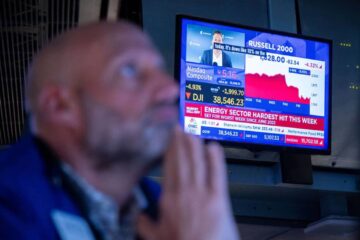This year, there has been considerable debate over whether the U.S. economy will experience stagflation or, worse, a recession.
Those who believe the economy faces a reckoning point to negative GDP growth, increasing job losses, and the effects of the trade war on inflation and supply chains. Others point to a historically low unemployment rate, wages outpacing inflation, and supporting spending as reasons we’ll avoid a recession.
Related: Goldman Sachs unveils tariffs prediction, recession forecast
It’s undeniably hard to predict what will happen to the economy next. Still, investors are right to worry about a recession because slowing sales and profits are big headwinds to corporate America. Given that stock prices follow earnings over time, the S&P 500’s returns during a recession are unsurprisingly lackluster, according to Fidelity Investments.
However — there is one silver lining about recessions that investors should remember.
The S&P 500 is down year-to-date on worries that the U.S. economy might enter a recession.
What is a recession and is one likely in 2025?
Gross domestic product is a measure of economic activity, and a recession is commonly described as two or more consecutive quarters of contracting GDP. However, that’s not always the case.
The official declaration of a recession is made by the National Bureau of Economic Research, and it doesn’t always stick to the rule of two quarters of economic contraction.
💸💰Don’t miss the move: Subscribe to TheStreet’s free daily newsletter 💰💸
“They look at a range of indicators to gauge if the US is in recession,” said Naveen Malwal, institutional portfolio manager with Strategic Advisers LLC, a money-management arm of Fidelity Investments. “For example, they believed the 2020 recession took place from February to April of that year, which doesn’t line up with two entire quarters of GDP.”
Regardless of how NBER defines recession, recessions typically happen when unemployment rises and economic activity shrinks.
Related: Fed official sends strong message on inflation before China trade talks
We’re already seeing evidence of this happening. Although unemployment is historically low at 4.2%, it’s still up from its 3.4% low in 2023. Importantly, companies announced more than 602,000 layoffs in 2025 through April, the highest year-to-date showing since the U.S. Covid-19 shutdown in 2020, and 87% more than a year earlier.
Negative GDP, with a big asterisk
The first-quarter GDP numbers are also concerning. The BEA’s advance estimate of first-quarter GDP was negative 0.3%, marking the first negative GDP quarter since Covid.
However, that negative GDP print comes with a big asterisk. Many companies pulled forward imports to sidestep tariffs, sending imports soaring, and gold activity has surged. Eliminate those inputs from GDP’s calculation, and the economy flips to first-quarter growth.
Unemployment and GDP are lagging indicators of economic health, though. What about leading indicators? Well, they’re sending mixed signals.
More Economic Analysis:
Fed inflation gauge sets up stagflation risks as tariff policies biteU.S. recession risk leaps as GDP shrinksLike it or not, the bond market rules all
For example, the Conference Board’s Expectations Index has slumped to 54.4. Typically, readings below 80 signal that a recession is on the horizon. Also, the ISM Manufacturing index remains below 50 at 48.7, signaling contraction.
Yet the Conference Board’s Leading Economic Index for March was still above water at 100.5, even as it declined 1.2% over the past six months.
As a result, the Conference Board’s current estimate is that the economy this year will slow but still grow.
“The Conference Board downwardly revised our US GDP growth forecast for 2025 to 1.6%, which is somewhat below the economy’s potential,” said Justyna Zabinska-LaMonica, senior manager for business cycle indicators at the Conference Board.
“The slower projected growth rate reflects the impact of deepening trade wars, which may result in higher inflation, supply chain disruptions, less investing and spending, and a weaker labor market.”
Goldman Sachs currently pegs the chances of a recession this year at 40%.
What happens to the S&P 500 during a recession?
To paraphrase Mark Twain, history rhymes. While nobody can precisely predict what stocks will do, the past can provide clues.
The bad news? Stocks typically generate poor returns during a recession. The good news? Recession-driven stock market declines can set up strong returns once the economy is back on track, according to Fidelity’s number crunching.
Related: Legendary fund manager sends blunt 7-word message on stocks
Since 1950, Fidelity notes 11 business cycles through 2024. The average duration of a recession was 11 months, and the S&P 500’s average annualized return during a recession is only 1%. That’s a far cry below the S&P 500’s average annualized return of about 10% since 1957, and south of the current 10-year Treasury note yield of 4.3%.
According to Fidelity, defensive stocks tend to perform best during a recession. Consumer staples, health care, telecom and utilities outperform, while technology and financial stocks are the worst performers.
Growth sectors tend to ouperform during expansion phases, while defensive sectors lead in a recession.
Fidelity.
While nondiscretionary sectors tend to provide the best recessionary returns, investors might not want to change their portfolios dramatically.
Expansions that follow recessions last far longer, and stocks tend to bottom before a recession is over, producing their best gains in the first year.
Fidelity’s data show that the typical expansion period since 1950 lasts 65 months, and the average annualized return during economic expansions is a robust 15%.
Importantly, stocks bottom before the economy does, and nobody rings a bell signaling the stock market’s low. As a result, many who sell for fear of a recession are slow to buy back in, missing out on some of the most impressive returns.
According to CFRA, the average first-year return of a bull market is an eye-watering 38%. The second-year return is just 12%.
“What we know from history is that recessions come and go,” Strategic Advisers’ Malwal says. “Historically, when investors get out of the market at a time like this, it’s rare for them to get back in at the right time, and this often leads to them missing out when things start to improve.”
Related: Veteran fund manager unveils eye-popping S&P 500 forecast


